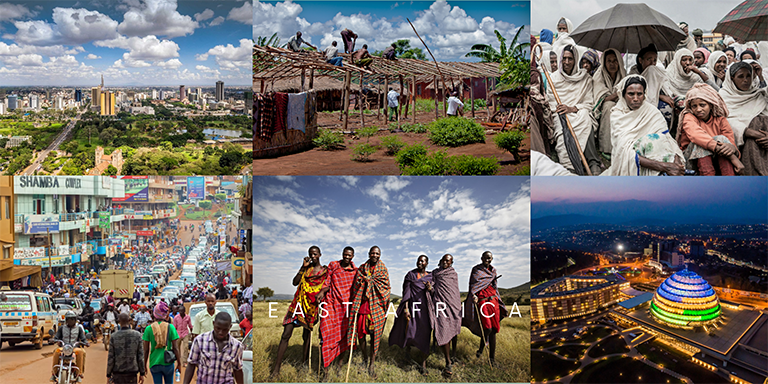East Africa
East Africa encompasses the eastern sub-region of Africa and includes large economic powerhouses such as Kenya, Ethiopia, and Tanzania. This region of the African continent also displays a remarkable diversity in geography and culture. Noticeable distinctions must be further made to better understand the intricacies and complexities of this region. Facing the Indian Ocean is the Horn of Africa, which includes the nation-states of Djibouti, Eritrea, Ethiopia, and Somalia, while situated geographically south of the Horn of Africa are the nations of the East African Community: South Sudan, Tanzania, Kenya, Uganda, Burundi, and Rwanda. Further south, close to the African sub-region of Southern Africa, are the countries of Mozambique and Malawi, Zimbabwe, and Zambia. Small island nations also dot the border of East Africa with the Indian Ocean, such as the French Overseas territories of Reunion and Mayotte, as well as the states of Comoros, Mauritius, and Seychelles.
Standing in stark contrast to North Africa, which is characterized by predominantly arid and desert environments, with the Saharan desert straddling the southern portion of several North African countries, the countries of East Africa contain much more green and luscious vegetation, as evidenced by the abundant populations of fauna. Home to Mount Kilimanjaro and Mount Kenya, as well as the world’s second-largest freshwater lake, East Africa is blessed with a stunning diversity of climate and geography. Whereas the coast of Mogadishu may typically have little to no rain in a year, the rainfall in the Ethiopian and Eritrean highlands exhibits tropical characteristics of rainfall, with a single wet season.
A target of European colonial expansion, East Africa faced several incursions from European powers looking to utilize the favorable position of territories and nations on the Indian Ocean to control international trade. With an eye on eliminating the monopoly Venice had constructed for the trade of spices and other profitable goods, King Manuel I of Portugal sponsored the expedition of Vasco Da Gama to find a sea route to the trading empires of the east, thus circumventing the onerous and tax-laden land routes from the east to the west via the Silk Roads. In essence, the unique geography and favorable vantage point over the nexus of international trade attracted European colonialists to establish empires and to jostle for power in the region. For instance, Portugal, the United Kingdom, France, and Italy all competed for preeminence in East Africa. Consequently, European languages are still commonly spoken, such as French, Portuguese, and English, which are especially the languages of higher institutions. Among the countries of the Horn of Africa, Afroasiatic languages abound: Semitic, Cushitic, and Omotic are widely spoken, whereas to the south, Niger-Congo languages of the Bantu branch are more common. Nilotic languages are also present throughout the region.

NEWS & ANALYSIS ON EAST AFRICA








